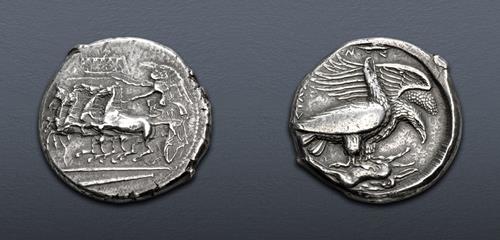|
SICILY, Akragas. Circa 410-406 BC. AR Tetradrachm (26mm, 17.43 g, 12h). Reverse die signed by Silanos. Nike, wearing long chiton, holding kentron in extended right hand, reins in left, driving fast quadriga left; above, AKPAΓ/ANTIN-O[N] in two lines on tablet (partially retrograde, last two letters outside tablet); in exergue, club left / Two eagles standing right on dead hare below, the closest eagle with wings closed and head raised, the further eagle with wings spread and head lowered; ΣIΛA-NOΣ along left edge. Westermark, Coinage, Period III, 595.1 (O7/R11) = Seltman, Engravers 16c (dies J/o) = Gillet 356 = SNG Spencer 30 = Seltman, Greek, pl. 26, 11 = Woodward 50 = Giesecke pl. 6, 5 (this coin); HGC 2, 86; SNG ANS 1000 (same dies); Berlin 582 (same dies); SNG Fitzwilliam 917 (same dies); Dewing 565 (same dies); Gulbenkian 170 (same dies); McClean 2041 (same dies); Rizzo pl. III, 3 (same dies). Wonderful old collection tone, slight doubling on obverse. Good VF. Click here for a video presentation on this collection.
From the Gerald F. Borrmann (Northern California Gentleman) Collection. Ex Christie’s (30 November 1990), lot 31; Charles Gillet (†1972) Collection; Capt. C. E. Spencer-Churchill Collection (Ars Classica XVI, 3 July 1933), lot 432; W. H. Woodward Collection; Ars Classica XV (2 July 1930), lot 271; Egger XLV (12 November 1913), lot 234; Gustave Durulfé Collection (Rollin & Feuardent, 9 May 1910), lot 120.
The late coinage of Akragas, struck in the years just before the Carthaginian capture of the city in 406 BC, was the most magnificent in the city’s history. It included the famous dekadrachm, gold pieces, and a variety of quadriga/two eagles tetradrachms that are all of superb quality. Seltman suggested that some of the finest engravers in Sicily made the dies for these coin, ascribing the obverse of this piece to Kimon, while the reverse is signed by the master Silanos. The symbols most associated with the coinage of Akragas are the eagle and the crab. Sometime after 420 BC, the Akragantines replaced the single eagle with a pair of eagles standing on a hare, the inspiration for which must have come from the Agamemnon of Aeschylus where men saw two eagles, representing Agamemnon and Menelaos, feasting upon a pregnant hare. It has always been believed that the city's dekadrachms were issued to celebrate the victory of Exainetos, an Akragantine, at the Olympic Games in 412 BC. It seems more likely, however, that they were part of the war preparations of Akragas against their enemy Carthage shortly before 406 BC. This tetradrachm is every bit the equal of the dekadrachm in terms of development of the traditional Akragantine themes and fineness of their representation.
The final winners of all Triton XXVIII lots will be determined at the live public sale that will be held on 14-15 January 2025.
Triton XXVIII – Session One – Lot 1–287 will be held Tuesday morning, 14 January 2025 beginning at 9:00 AM ET.
Winning bids are subject to a 22.5% buyer's fee for bids placed on this website and 25% for all others.
We recognize that our users may have various Internet Browsers and Operating Systems. We like our visitors to have the best possible experience when using our bidding platform. However, we do recognize that it is impossible to develop applications that work identically, efficiently and effectively on all web browsers. The CNG bidding platform supports the latest stable major version and stable previous version of Chrome and Firefox.
|
